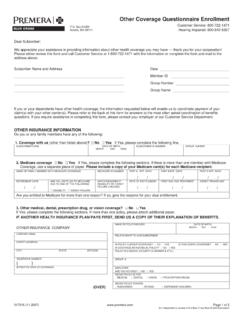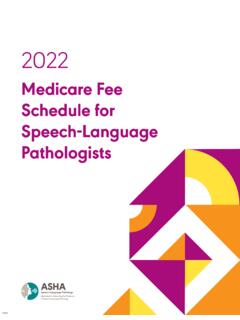Transcription of 10.01.521 Routine Vision Care - Premera Blue Cross
1 BENEFIT COVERAGE GUIDELINE Routine Vision Care Effective Date: Dec. 1, 2021 RELATED MEDICAL POLICIES / GUIDELINES: Last Revised: Nov. 9, 2021 Orthoptic and Vision Therapy, Visual Perceptual Training, Vision Replaces: N/A Restoration Therapy, and Neurovisual Rehabilitation Select a hyperlink below to be directed to that section. BENEFIT COVERAGE CRITERIA | CODING | RELATED INFORMATION. EVIDENCE REVIEW | REFERENCES | HISTORY. Clicking this icon returns you to the hyperlinks menu above. Introduction Vision services is a broad term that means care of the eyes. Vision services are usually either Routine or medical.
2 Although the exams and activities may be similar, the reason for the visit determines whether it's a Routine or medical visit. Visiting an ophthalmologist (a medical doctor). does not necessarily make the visit or exam medical in nature. Benefits vary depending on the reason for the examination. Routine eye exam: Routine eye exams are often done to find the cause of blurry Vision (such as myopia, presbyopia, hyperopia and astigmatism). After a Routine exam, a prescription for corrective lenses (glasses/contact lens) may be given to the patient. If the plan offers a Routine Vision benefit, the Routine services are covered at the level stated in the member's contract.
3 If the plan does not offer a Routine Vision benefit, Routine services are not covered. Medical eye exam: Medical eye exams are often done to diagnose, treat, or monitor eye conditions or injuries such as an infection, eye trauma, glaucoma, diabetic retinopathy, macular degeneration, or cataracts to name a few. Note: The Introduction section is for your general knowledge and is not to be taken as policy coverage criteria. The rest of the policy uses specific words and concepts familiar to medical professionals. It is intended for providers. A provider can be a person, such as a doctor, nurse, psychologist, or dentist.
4 A provider also can be a place where medical care is given, like a hospital, clinic, or lab. This policy informs them about when a service may be covered. Benefit Coverage Criteria Procedure / Service Coverage Criteria Vision exams covered If the member has a Vision care benefit, the plan will cover under the Vision Care Routine Vision exams for the diagnoses listed in the Coding benefit table below from the Vision exams benefit. Covered Routine Vision exams include: Examination of the outer and inner parts of the eye Evaluation of Vision sharpness (refraction). Binocular balance testing Routine tests of color Vision , peripheral Vision , and intraocular pressure Case history and recommendations The Routine Vision exams benefit does NOT cover Vision hardware or fitting examinations for contact lenses or eyeglasses When the plan does not have a Routine Vision care benefit, eye refractions and examinations classified as Routine are Not Covered.
5 This includes services to prescribe, fit, or change eyeglasses or contact lenses Vision Hardware for If the member has a Vision hardware benefit and is 19 years of members 19 and older age or older, the plan covers the following: Prescription eyeglass lenses (single Vision , bifocal, trifocal, progressive, quadrifocal, or lenticular). Frames for eyeglasses Prescription contact lenses (soft, hard, or disposable). Prescription safety glasses Prescription sunglasses Special features, such as tinting or coating Fitting of eyeglass lenses to frames Fitting of contact lenses to the eyes Page | 2 of 8.
6 The Vision Hardware benefit does NOT cover any of the following: Non-prescription eyeglasses or contact lenses, or other special purpose Vision aids (such as magnifying attachments), or light- sensitive lenses, even if prescribed Supplies used for the maintenance of contact lenses (eg, wetting and cleaning solutions, carrying cases). Vision therapy, eye exercise, or any sort of training to correct muscular imbalance of the eye (orthoptics), or pleoptics (see Related Policies). Vision exams covered Vision exams may be covered under the medical benefit when under the medical benefit a disease/condition of the eye is found or is reasonably suspected, or when the member is undergoing long-term treatment with a high-risk medication.
7 The medical record must clearly document the specific condition, or the high-risk medication being used Medical Vision hardware Medical Vision hardware for members age 19 and older is for members age 19 and covered to correct Vision due to the following medical eye older conditions: Aniridia Aniseikonia Anisometropia Aphakia Bullous keratopathy Congenital cataract Corneal abrasion Corneal disorders Corneal ulcer Irregular astigmatism Keratoconus Pathological myopia Post-traumatic disorders Progressive high (degenerative) myopia Recurrent erosion of the cornea Sjogren's disease Tear film insufficiency Page | 3 of 8.
8 Coding Codes listed in this guideline are for reference only. Listing of a code does not imply that the service described by this code is a covered or non-covered service. Inclusion of a code does not imply any right to reimbursement or guarantee of claims payment. The following diagnoses codes are considered as Routine Vision services. Code Description ICD-10 Diagnosis Codes Hypermetropia, unspecified eye Hypermetropia, Right eye Hypermetropia, Left eye Hypermetropia, Bilateral eye Myopia, unspecified eye Myopia, right eye Myopia, left eye Myopia, bilateral eye Unspecified Astigmatism, right eye Unspecified Astigmatism, left eye Unspecified Astigmatism, bilateral Unspecified Astigmatism, unspecified eye Regular Astigmatism, right eye Regular Astigmatism, left eye Regular Astigmatism, bilateral Regular Astigmatism, unspecified eye Presbyopia Internal ophthalmoplegia (complete) (total), right eye Page | 4 of 8.
9 Code Description Internal ophthalmoplegia (complete) (total), left eye Internal ophthalmoplegia (complete) (total), bilateral Internal ophthalmoplegia (complete) (total), unspecified eye Paresis of accommodation, right eye Paresis of accommodation, left eye Paresis of accommodation, bilateral Paresis of accommodation, unspecified eye Spasm of accommodation, right eye Spasm of accommodation, left eye Spasm of accommodation, bilateral Spasm of accommodation, unspecified eye Other disorders of refraction Unspecified disorder of refraction Unspecified disorder of refraction Glare Sensitivity Impaired contrast Sensitivity Encounter for screening for eye and ear disorders Encounter for examination of eyes and Vision without abnormal findings (Encounter for examination of eyes and Vision NOS).
10 Encounter for examination of eyes and Vision with abnormal findings (Use additional code to identify abnormal findings). Encounter for fitting and adjustment of spectacles and contact lenses Related Information Definition of Terms Aniridia: The absence of part or all of the iris, the colored part of the eye. Page | 5 of 8 . Aniseikonia: An ocular defect in which the images on the retinas are different in size. Anisometropia: A condition in which the eyes have different refractive power causing the eyes to focus unevenly. Aphakia: The absence of the lens of the eye. Aphakia may be caused by a genetic defect, surgical removal of a cataract, or an injury.











